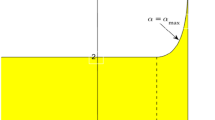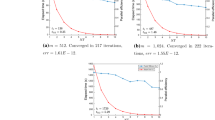Abstract
A classical method for solving the variational inequality problem is the projection algorithm. We show that existing convergence results for this algorithm follow from one given by Gabay for a splitting algorithm for finding a zero of the sum of two maximal monotone operators. Moreover, we extend the projection algorithm to solveany monotone affine variational inequality problem. When applied to linear complementarity problems, we obtain a matrix splitting algorithm that is simple and, for linear/quadratic programs, massively parallelizable. Unlike existing matrix splitting algorithms, this algorithm converges under no additional assumption on the problem. When applied to generalized linear/quadratic programs, we obtain a decomposition method that, unlike existing decomposition methods, can simultaneously dualize the linear constraints and diagonalize the cost function. This method gives rise to highly parallelizable algorithms for solving a problem of deterministic control in discrete time and for computing the orthogonal projection onto the intersection of convex sets.
Similar content being viewed by others
References
B.H. Ahn and W.W. Hogan, “On convergence of the PIES algorithm for computing equilibria,”Operations Research 30 (1982) 281–300.
A. Auslender,Optimization: Méthodes Numériques (Masson, Paris, 1976).
M.L. Balinksi and R.W. Cottle, eds.,Mathematical Programming Study 7: Complementarity and Fixed Point Problems (North-Holland, Amsterdam, 1978).
D.P. Bertsekas,Constrained Optimization and Lagrange Multiplier Methods (Academic Press, New York, 1982).
D.P. Bertsekas and J.N. Tsitsiklis,Parallel and Distributed Computation: Numerical Methods (Prentice-Hall, Englewood Cliffs, NJ, 1989).
H. Brézis,Opérateurs Maximaux Monotones (North-Holland, Amsterdam, 1973).
R.E. Bruck Jr., “An iterative solution of a variational inequality for certain monotone operators in Hilbert space,”Bulletin of the American Mathematical Society 81 (1975) 890–892.
R.W. Cottle, F. Giannessi and J.-L. Lions, eds.,Variational Inequalities and Complementarity Problems: Theory and Applications (Wiley, New York, 1980).
S. Dafermos, “An iterative scheme for variational inequalities,”Mathematical Programming 26 (1983) 40–47.
K. Deimling,Nonlinear Functional Analysis (Springer, Berlin, 1985).
B. Feijoo and R.R. Meyer, “Piecewise-linear approximation methods for nonseparable convex optimization,”Management Science 34 (1988) 411–419.
D. Gabay, “Applications of the method of multipliers to variational inequalities,” in: M. Fortin and R. Glowinski, eds.,Augmented Lagrangian Methods: Applications to the Numerical Solution of Boundary-Value Problems (North-Holland, Amsterdam, 1983).
R. Glowinski, J.-L. Lions and R. Trémoliéres,Numerical Analysis of Variational Inequalities (North-Holland, Amsterdam, 1981).
A.A. Goldstein, “Convex programming in Hilbert spaces,”Bulletin of the American Mathematical Society 70 (1964) 709–710.
L.G. Gubin, B.T. Polyak E.V. Raik, “The method of projections for finding the common point of convex sets,”Ž. Vyčhisl. Mat. i Mat. Fiz. 7 (1967) 1211–1228;USSR Computational Mathematics and Mathematical Physics 6 (1967) 1–24.
S.P. Han, “A successive projection method,”Mathematical Programming 40 (1988) 1–14.
S.P. Han and G. Lou, “A parallel algorithm for a class of convex programs,”SIAM Journal on Control and Optimization 26 (1988) 345–355.
D. Kinderlehrer and G. Stampacchia,An Introduction to Variational Inequalities and their Applications (Academic Press, New York, 1980).
B. Lemaire, “Coupling optimization methods and variational convergence,” in: K.-H. Hoffman, J.-B. Hiriart-Urruty, J. Zowe and C. Lemarechal, eds.,Trends in Mathematical Optimization (Birkhäuser, Basel, 1988) pp. 163–179.
Y.Y. Lin and J.-S. Pang, “Iterative methods for large convex quadratic programs: A survey,”SIAM Journal on Control and Optimization 25 (1987) 383–411.
P.L. Lions and B. Mercier, “Splitting algorithms for the sum of two nonlinear operators,”SIAM Journal on Numerical Analysis 16 (1979) 964–979.
Z.-Q. Luo and P. Tseng, “On the convergence of a matrix-splitting algorithm for the symmetric linear complementarity problem,” LIDS Report P-1884, M.I.T. (Cambridge, MA, 1989).
O.L. Mangasarian, “Solution of symmetric linear complementarity problems by iterative methods,”Journal of Optimization Theory and Applications 22 (1977) 465–485.
G.J. Minty, “Monotone (nonlinear) operators in Hilbert space,”Duke Mathematical Journal 29 (1962) 341–346.
G.J. Minty, “On the monotonicity of the gradient of a convex function,”Pacific Journal of Mathematics 14 (1964) 243–247.
J.J. Moreau, “Proximité et dualité dans un espace Hilbertien,”Bulletin de Société Mathématique de France 93 (1965) 273–299.
K.G. Murty,Linear Complementarity, Linear and Nonlinear Programming (Heldermann, Berlin, 1988).
J.-S. Pang, “Necessary and sufficient conditions for the convergence of iterative methods for the linear complementarity problem,”Journal of Optimization Theory and Applications 42 (1984) 1–17.
J.-S. Pang, “Asymmetric variational inequality problems over product sets: Applications and iterative methods,”Mathematical Programming 31 (1985) 206–219.
J.-S. Pang and D. Chan, “Iterative methods for inequality and complementarity problems,”Mathematical Programming 24 (1982) 284–313.
G.B. Passty, “Ergodic convergence to a zero of the sum of monotone operators in Hilbert space,”Journal of Mathematical Analysis and Applications 72 (1979) 383–390.
R.T. Rockafellar,Convex Analysis (Princeton University Press, Princeton, NJ., 1970).
R.T. Rockafellar, “On the maximality of sums of nonlinear monotone operators,”Transactions of the American Mathematical Society 149 (1970) 75–88.
R.T. Rockafellar, “Monotone operators and the proximal point algorithm,”SIAM Journal on Control and Optimization 14 (1976) 877–898.
R.T. Rockafellar,Network Flows and Monotropic Optimization (Wiley, New York, 1984).
R.T. Rockafellar, “Generalized linear-quadratic programming and optimal control,”SIAM Journal on Control and Optimization 25 (1987) 781–814.
R.T. Rockafellar and R.J.-B. Wets, “Generalized linear-quadratic problems of deterministics and stochastic optimal control in discrete time,” Technical Report, Department of Mathematics, University of Washington (Seattle, WA, 1987).
M. Sibony, “Méthodes itératives pour les équations et inéquations aux dérivées partielles nonlinéaires de type monotone,”Calcolo 7 (1970) 65–183.
P. Tseng, “Applications of a splitting algorithm to decomposition in convex programming and variational inequalities,” to appear in:SIAM Journal on Control and Optimization.
Author information
Authors and Affiliations
Additional information
This research is partially supported by the U.S. Army Research Office, contract DAAL03-86-K-0171 (Center for Intelligent Control Systems), and by the National Science Foundation under grant NSF-ECS-8519058.
Thanks are due to Professor J.-S. Pang for his helpful comments.
Rights and permissions
About this article
Cite this article
Tseng, P. Further applications of a splitting algorithm to decomposition in variational inequalities and convex programming. Mathematical Programming 48, 249–263 (1990). https://doi.org/10.1007/BF01582258
Received:
Revised:
Issue Date:
DOI: https://doi.org/10.1007/BF01582258




